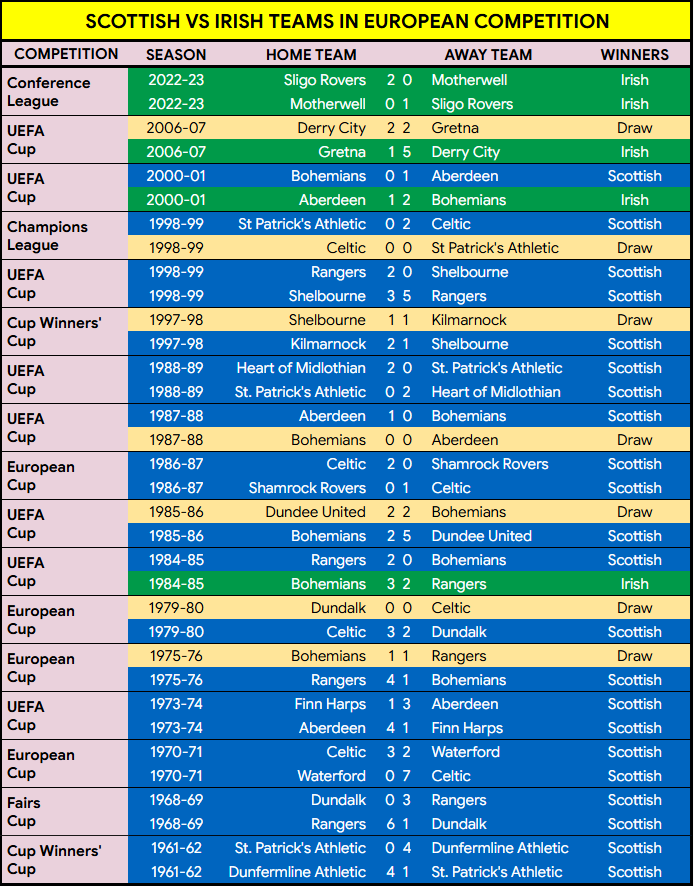Soaring crowds. A booming women's game. European progression. What Scotland can learn from Irish football ☘️
The data that tells us the gap is closing with our Celtic cousins
Viewed from over the water, football in the Republic of Ireland appears to be thriving. On the field, relative success in European competition suggests sporting progression. Off it, a vibrant supporter culture has emerged from the shadows of the nation’s other favourite sports. Over three print articles in issue 36 - and starting with today’s piece on Nutmeg FC - we’re examining how much truth there is in this apparent boom, and what Scottish football might learn from it.
By Gavin Noon
Since the UEFA coefficient was officially introduced in 1979, the Republic of Ireland’s league has never broken into the top 20. By contrast, Scotland has been outside the top 20 for only two periods (1997–99 and 2013–19) and reached as high as third place four times in the 1960s. Over 66 seasons, Scotland has finished in the top ten 31 times.
So how do we explain that the Irish national team has progressed from the group stage in all three World Cups they’ve qualified for, and once in the Euros too — while Scotland has never managed it in either competition? How can it be that this season we witnessed an Irish club side — Shamrock Rovers — progress beyond the league phase of the Conference League, while no Scottish club outside of Glasgow has done so since Aberdeen in 2008?
It may be a fairer examination of the respective European performances if we instead only compare matches won in European competition from the turn of this century, excluding Celtic and Rangers from the calculation. So we’re eliminating all qualifiers and we’re taking out Scotland’s two coefficient powerhouses, whose financial power skews comparisons between the two leagues.
Up until the beginning of the 2024/25 campaign, Irish clubs had managed just two non-qualifier wins in European competition, while for Scotland it was 11 victories. Shamrock Rovers then tripled that Irish total to six, while Hearts moved the non-Old firm tally up to 13.
Thirteen wins to six over the past 25 years is not quite the chasm in European performance that the coefficient rankings would suggest, and Scotland’s high ranking is clearly largely dependent on Rangers and Celtic. They now contribute 75%+ of the coefficient points earned by Scottish teams.
DIRECT MEETINGS
There have been 34 Scottish v Irish encounters in European club football. Scottish teams have only lost five of these matches. However, four of those Scottish losses came this century, and of the last six meetings there has only been one Scottish victory — even that was a 1-0 win for Aberdeen in Dublin that suited Bohemians, who progressed via the away goals rule (after playing the second half with 10 men).
That’s three qualifying ties since 2000 and on each occasion the Irish side has progressed to the next round. When Gretna entered as Scottish Cup runners-up, they suffered what was at the time the joint record home defeat for a Scottish side in Europe. I would expect that any meeting between Scottish and Irish sides in the coming seasons could be equally as dangerous.
Since 2003, the Irish league has played between February and December. In these early rounds of UEFA competition when Ireland-Scotland matches are most likely, the Irish players are midway through their season, while their Scottish counterparts are just back from their holidays.
A RISE IN IRISH FOOTBALL?
Detractors of Scottish football often compare it to the English game. However, in modern-day football the disparity in quality between the two countries can almost always be attributed to finance. For example, clubs in the third tier of English football received around £1.7million each from the EFL last season — a Scottish club would have to finish eighth in the Scottish Premiership to earn that. The team finishing bottom of the English Premier League received £110m. It’s simply a different financial universe.
When comparing Irish and Scottish football, we have to be cognisant of a similar, but not as pronounced, financial distortion. The winners of the League of Ireland Premier Division receive €125,000. Kelty Hearts received more for finishing sixth in League One.
However, despite the lack of finances, the Irish league has improved markedly in recent years. Attendances rose 77% between 2019 and 2023, with stadiums regularly sold out. There is a ceiling to this though, as Gary Spain, Republic of Ireland’s Supporters Liaison Officer, explained.
“Domestic football is at an all-time high”, he said. “Many teams now play in front of sellout crowds although due to chronic underinvestment in facilities, these numbers could be much higher. This is despite the fact there will be 4,000 fans travelling from the Republic of Ireland to any Manchester United home game, and the same in proportion at Anfield.
“The national team has been at a low ebb in recent years. The halcyon days of Irish football were from 1988-2002, with three appearances in four World Cups, setting expectations that these days could continue forever. Losing on penalties to Spain in Suwon remains the last World Cup finals game for our men, but signs are very positive with some talented young players making an impact.
“Women’s football has been a huge success story. After decades of playing in front of sparse crowds with little media coverage the national team have become household names. Qualifying for the 2023 FIFA World Cup thanks to a shock win at Hampden was a huge boost”
Spain describes a growing game, with fan interest at record levels. If they can increase investment in stadiums, grow sponsorship and TV revenue, then Irish clubs could go on to prove that Shamrock Rovers’ heroic Conference League campaign of 2024/25 was not just a one-off. That penalty shootout loss to Molde in the knockout round will give renewed belief that they can win games and progress in the new third tier of European football.

From a Scottish football point of view, Shamrock Rovers have undoubtedly set the bar. Watching a 16-year-old score the winning goal for an Irish side in a European knockout tie in Norway really hammers home that there should be no barrier to our Scottish sides from Edinburgh, Aberdeen or Dundee achieving similar in the coming years.
For more on our League of Ireland series, including Nick Harris’ investigation into the league’s finances in relation to Scotland, subscribe to Nutmeg’s print magazine





